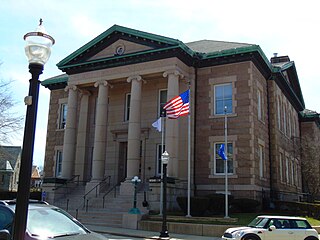
Westerly is a town on the southwestern coastline of Washington County, Rhode Island, first settled by English colonists in 1661 and incorporated as a municipality in 1669. It is a beachfront community on the south shore of the state with a population of 23,359 as of the 2020 census.

Castle Hill Lighthouse is located on Narragansett Bay in Newport, Rhode Island at the end of the historic Ocean Drive. It is an active navigation aid for vessels entering the East Passage, between Conanicut Island and Aquidneck Island. The lighthouse has become a symbol of Newport, and a frequent site for wedding photos, proposals, and tourist photos. Although the property is owned by the nearby Castle Hill Inn, the lighthouse is owned by the United States Coast Guard.

Weekapaug is a census-designated place in southern Washington County, Rhode Island, part of the town of Westerly, Rhode Island. The population was 425 at the 2010 census.
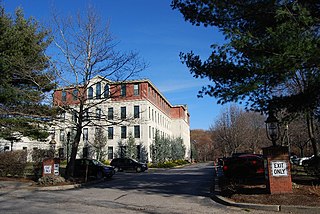
Georgiaville is a village in Smithfield, Providence County, Rhode Island, United States. The village was named after the Georgia Cotton Manufacturing Company mill located in the area. The Georgiaville Pond Beach is located in the village and is a popular recreation spot. In the 1920s the Ku Klux Klan was active in the area, and Klan rallies were held in Georgiaville. The village, which has retained many features of its origin as a mid-19th century mill village including the mill complex and several blocks of mill worker housing, was added to the National Register of Historic Places in 1985. Georgiaville is also where Smithfield's town hall is located.

Great Friends Meeting House is a meeting house of the Religious Society of Friends (Quakers) built in 1699 in Newport, Rhode Island. The meeting house, which is part of the Newport Historic District, is currently open as a museum owned by the Newport Historical Society.

The Smith–Appleby House Museum is a historic house museum in Smithfield, Rhode Island. It is now home to the Smithfield Historical Society.

Saylesville is a village and historic district in Lincoln, Rhode Island.
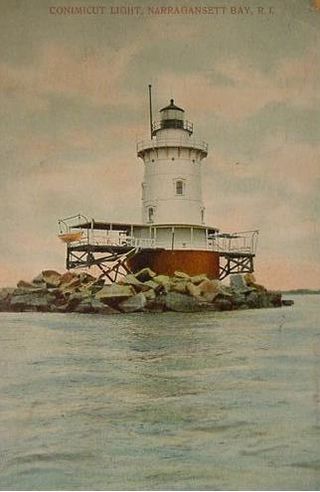
Conimicut Light, built in 1883, is a historic sparkplug lighthouse in Warwick, Rhode Island. The lighthouse was listed on the National Register of Historic Places in 1988. The lighthouse is said to be in "relatively good condition."
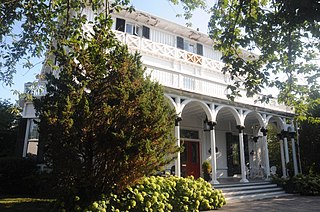
The Hamilton Hoppin House is an historic house at 120 Miantonomi Ave in Middletown, Rhode Island. It has been known by several names, including Villalon, Montpelier, Shadow Lawn, Agincourt Inn, and, currently, The Inn at Villalon.

The Stone House Inn, also known as the David Sisson House, located at 122 Sakonnet Point Road in Little Compton, Rhode Island, is a large four-story fieldstone residence – built in 1854 for David Sisson, a Providence-based industrialist – and its associated c.1886 barn. The structures sit on 2 acres of land overlooking Round Pond to the south, with a view of the Sakonnet River and Sakonnet Harbor to the west. When the house was completed, it was the largest single-family dwelling in that region and the only one built of stone.

Arnold Mills Historic District is a historic district encompassing a modest 19th-century mill village in eastern Cumberland, Rhode Island. The district lies along the Nate Whipple Highway and Sneech Pond Road, south of the Arnold Mills Reservoir. Sneech Pond Road was formerly the major east-west highway through the area prior to the construction of the Nate Whipple Highway in the 1960s. The Arnold Mills village is in part bisected by Abbott Run, the stream which serves as the outlet of the reservoir; Sneech Pond Road crosses the run on an early 20th-century steel Pratt pony truss, now closed to vehicular traffic. The houses along this road generally date from the late 18th to mid-19th century, and mainly reflect Federal and Greek Revival styling. The most prominent structure in the district is the Arnold Mills United Methodist Church, located at the western end of the district on Nate Whipple Highway; it was built 1825-27 and remodeled in 1846.

Browning's Beach Historic District is a historic district west of the junction between Card Pond and Matunuck Beach Roads in South Kingstown, Rhode Island. It encompasses a cluster of four beach houses located on a barrier beach facing Long Island Sound south of Cards Pond, and accessed via a private gravel drive extending from Cards Pond Road. The four houses, along with several outbuildings, were built in the early years of the 20th century, and are architecturally diverse expressions of Queen Anne, Shingle, and Colonial Revival elements. Typical architectural elements include shingle siding, recessed porches, and chalet-style roofs.
The Peleg Champlin House is an historic house on Rodman Pond Lane in western New Shoreham, on Block Island, in Rhode Island. It is a 1+1⁄2-story wood-frame structure, five bays wide, with a side-gable roof and a large central chimney. An ell extends from the back (north) side of the house. The Federal style wooden house was built c. 1820 by Peleg Champlin, a farmer from one of the island's older families. The house is one of the best-preserved houses of the period on the island.

Dewey Cottage is a historic house in South Kingstown, Rhode Island.
The Great Salt Pond Archeological District is a historic district in New Shoreham, Rhode Island. The district was added to the National Register of Historic Places in 1990.

The Greene Inn was a historic summer resort hotel at 175 Ocean Road in Narragansett, Rhode Island.
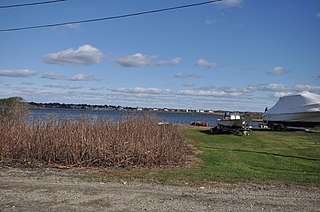
The Potter Pond Archeological District is a large complex of archaeological sites in coastal South Kingstown, Rhode Island. The area is roughly bounded by United States Route 1, Point Judith Pond, Matunuck Beach Road, and the south coast, and includes 22 archaeologically significant sites dating from the Late Archaic through the Late Woodland periods.
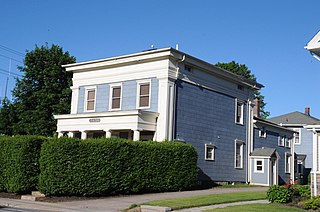
The North End Historic District is a predominantly residential historic district in northwestern Westerly, Rhode Island. The area traces the industrial development of Westerly, with proximity to both its central business district as well as water-based textile mills, and stone quarries further inland. Most of the district's architecture was built between 1832 and 1955. The district is bounded on the east by High Street; on the south by properties on Friendship, West, Pleasant Streets, Marriott Avenue and Industrial Drive; on the west by properties on Pleasant, Canal, Pierce and Pond Streets; and on the north by properties on Pond, Pierce, Pearl, and High Streets, and Turano Avenue.
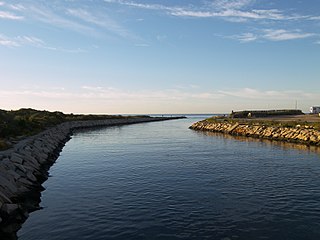
Winnapaug Pond is a breached saltwater lagoon in Westerly, Rhode Island, United States, connected to Block Island Sound by the Weekapaug Breachway, which was constructed during the mid-1950s. The 2.5-mile (4.0 km) lake is separated from the Atlantic by a large sandbar. The Atlantic side of the sandbar is lined by beaches, including Misquamicut Beach, Atlantic Beach, and Westerly Town Beach. In 2010, its overall water quality was assessed as "good". Winnapaug is relatively small and shallow, and is favorable for kayaking. It is one of nine coastal lagoons, referred to as "salt ponds" by locals, in southern Rhode Island.

Quonochontaug is a coastal lagoon in the towns of Charlestown and Westerly, both in Washington County, Rhode Island, United States. It is the most saline of nine such lagoons in southern Rhode Island.




















